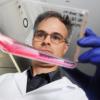This article addresses some of the relationships of consumption with demand, and supply, as well as profound cultural distinction when we define "need".
The issues are linked but in many more ways than are generally addressed. Global Warming is an issue that in itself will have profound impact one way or another but it should be already understood to be having a profound impact and not merely one in the "future tense".
As Advancedatheist printed elsewhere this is also about energy: Who has it, who uses it, who needs it, why, and how?
What the full impact will ultimately be is uncertain except for one aspect that is being grossly overlooked by myopic mortals, it will force confrontation and change in an escalating spiral of chaotic reactionary socioeconomics and the longer we avoid dealing with the problem in order to defend the status quo the worse the likely outcome will be for the majority even if it serves the interests of minorities.
LL
***********
http://www.nytimes.c...rth/04ENER.html As Earth Warms, the Hottest Issue Is Energy
As Earth Warms, the Hottest Issue Is EnergyBy KENNETH CHANG
Published: November 4, 2003
Suppose that over the next decade or two the forecasts of global warming start to come true. Color has drained from New England's autumns as maple trees die, and the Baltimore oriole can no longer be found south of Buffalo. The Dust Bowl has returned to the Great Plains, and Arctic ice is melting into open water. Upheavals in weather, the environment and life are accelerating around the world.
Then what?
If global warming occurs as predicted, there will be no easy way to turn the Earth's thermostat back down. The best that most scientists would hope for would be to slow and then halt the warming, and that would require a top-to-bottom revamping of the world's energy systems, shifting from fossil fuels like coal, oil and natural gas to alternatives that in large part do not yet exist.
"We have to face the fact this is an enormous challenge," said Dr. Martin I. Hoffert, a professor of physics at New York University.
But interviews with scientists, environment advocates and industry representatives show that there is no consensus in how to meet that challenge. Some look to the traditional renewable energy sources: solar and wind. Others believe use of fossil fuels will continue, but that the carbon dioxide can be captured and then stored underground. The nuclear power industry hopes concern over global warming may help spur a revival.In an article in the journal Science last November, Dr. Hoffert and 17 other experts looked at alternatives to fossil fuels and found all to have "severe deficiencies in their ability to stabilize global climate."
The scientists believe that technological fixes are possible. Dr. Hoffert said the country needed to embark on an energy research program on the scale of the Manhattan Project that built the atomic bomb during World War II or the Apollo program that put men on the moon.
"Maybe six or seven of them operating simultaneously," he said. "We should be prepared to invest several hundred billion dollars in the next 10 to 15 years."
But to even have a hope of finding a solution, the effort must begin now, the scientists said. A new technology usually takes several decades to develop the underlying science, build pilot projects and then begin commercial deployment.
The authors of the Science paper expect that a smorgasbord of energy sources will be needed, and they call for intensive research on radical ideas like vast solar arrays orbiting Earth that can collect sunlight and beam the energy down. "Many concepts will fail, and staying the course will require leadership," they wrote. "Stabilizing climate is not easy."
The heart of the problem is carbon dioxide, the main byproduct from the burning of fossil fuels. When the atmosphere is rich in carbon dioxide, heat is trapped, producing a greenhouse effect. Most scientists believe the billions of tons of carbon dioxide released since the start of the Industrial Revolution are in part to blame for the one-degree rise in global temperatures over the past century. Carbon dioxide concentrations are now 30 percent higher than preindustrial levels.
With rising living standards in developing nations, emissions of carbon dioxide are increasing, and the pace of warming is expected to speed up, too. Unchecked, carbon dioxide would reach twice preindustrial levels by midcentury and perhaps double again by the end of the century. That could force temperatures up by 3 to 10 degrees Fahrenheit by 2100, according to computer models.
Because carbon dioxide is colorless, odorless and disperses immediately into the air, few realize how much spills out of tailpipes and smokestacks. An automobile, for example, generates perhaps 50 to 100 tons of carbon dioxide in its lifetime.
The United States produces more carbon dioxide than any other country by far. Each American, on average, generates about 45,000 pounds of carbon dioxide a year. That is about twice as much as the average person living in Japan or Europe and many times more than someone living in a developing country like Zimbabwe, China or Panama. (Even if the United States achieves President Bush's goal of an 18 percent reduction in the intensity of carbon dioxide emissions by 2012, the output of an average American would still far exceed that of almost anyone else in the world.)
Even if all emissions stop, levels of carbon dioxide in the air will remain high for centuries as the Earth gradually absorbs the excess.
Currently, the world's energy use per second is about 12 trillion watts — which would light up 120 billion 100-watt bulbs — and 85 percent of that comes from fossil fuels. 
Of the remaining 15 percent, nuclear and hydroelectric power each supply about 6.5 percent. The renewable energy sources often touted as the hope for the future — wind and solar — provide less than 2 percent.
In March, Dr. Hoffert and two colleagues reported in Science that to limit the temperature increase to 3.6 degrees Fahrenheit, non-carbon-dioxide-emitting sources would have to generate 7 trillion to 25 trillion watts by midcentury, 4 to 14 times as much as current levels. That is roughly equivalent to adding a large emissions-free power plant every day for the next 50 years.
And by the end of the century, they wrote, at least three-quarters and maybe all of the world's energy would have to be emission-free.
No existing technology appears capable of filling that void. The futuristic techology might be impractically expensive. Developing a solar power satellite, for example, has been estimated at more than $200 billion.
Energy Secretary Spencer Abraham cited the Science paper from last November in a speech at the American Academy in Berlin two months ago. Mr. Abraham said that merely setting limits and timetables on carbon dioxide like those in the Kyoto Protocol could not by themselves solve global warming.
"We will also need to develop the revolutionary technologies that make these reductions happen," Mr. Abraham said. "That means creating the kinds of technologies that do not simply refine current energy systems, but actually transform the way we produce and consume energy."
Too Far AwaySome long-hoped-for options will almost certainly not be ready. Fusion — producing energy by combining hydrogen atoms into helium, the process that lights up the sun — has been heralded for decades as a potentially limitless energy source, but scientists still have not shown it can be harnessed practically. Experimental fusion reactors do not yet produce more power than they take to run.
Increased energy efficiency — like better-insulated buildings, more efficient air-conditioners, higher mileage cars — is not a solution by itself, but it could buy more time to develop cleaner energy.
The much-talked-about hydrogen economy, in which gasoline-powered engines are replaced by fuel cells, is also not a solution. It merely shifts the question to what power source is used to produce the hydrogen.
Today, most hydrogen is made from natural gas, a process that produces carbon dioxide that is then released into the air. Hydrogen can also be produced by splitting apart water atoms, but that takes more energy than the hydrogen will produce in the fuel cell. If the electricity to split the water comes from the coal-fired power plant, then a hydrogen car would not cut carbon dioxide emissions.
 Wind turbines and solar power, which are renewable energy sources, provide less than 2 percent of the world's electricity. Exploiting What's Here
Wind turbines and solar power, which are renewable energy sources, provide less than 2 percent of the world's electricity. Exploiting What's HereA fundamental problem remains: how to produce electricity without carbon dioxide.
Hydroelectric power has reached its limits in most parts of the world; there are no more rivers to dam.
Nuclear power is a proven technology to generate large amounts of electricity, but before it could be expanded, the energy industry would have to overcome longstanding public fears that another accident, like those at Three Mile Island or Chernobyl, will occur. Solutions also need to be found for disposing of radioactive spent fuel and safeguarding it from terrorists.
Marvin Fertel, senior vice president of the Nuclear Energy Institute, an industry group, said warming had become such a worry that some environmental groups were becoming amenable to new nuclear plants. "In private, that's what we get from them," he said.
Researchers at the Electric Power Research Institute in Palo Alto, Calif., espouse a major expansion of nuclear power, coupled with a switch from gasoline to hydrogen to power cars and trucks. Electricity from the nuclear plants would split water to produce hydrogen, and then cables made of superconductors would distribute both electricty and hydrogen, which would double as coolant for the cables, across the country.
"I think in 30 to 50 years there will be systems like this," said Dr. Chauncey Starr, the institute's founder and emeritus president. "I think the advantages of this are sufficient to justify it."
In the short run, fossil fuels will still be widely used, but it is still possible to control carbon dioxide.
In his Berlin speech, Mr. Abraham highlighted two projects the Energy Department was working on: carbon sequestration — the capturing of carbon dioxide before it is emitted and storing it underground — and FutureGen, a $1 billion prototype coal power plant that will produce few emissions. The plant will seek to demonstrate by 2020 how to convert coal to hydrogen on a commercial scale that will then be used to generate electricity in fuel cells or turbines. The waste carbon dioxide would be captured and stored.
The technology for injecting carbon dioxide is straightforward, but scientists need better knowledge on suitable locations and leak prevention.
Sequestration, however, will probably not be cost-effective for current power plants. The filters for capturing carbon dioxide from the exhaust gas will by themselves consume 20 percent to 30 percent of the power plant's electricity.
Renewing RenewablesSolar is still a future promise. The cost of energy from solar cells has dropped sharply in the past few decades. One kilowatt-hour of electricity — the energy to light a 100-watt bulb for 10 hours — used to cost several dollars when produced by solar cells. Now it is only about 35 cents. With fossil fuels, a kilowatt-hour costs just a few cents.
But solar still has much room for improvement. Commercial cells are only 10 to 15 percent efficient. With much more research, new strategies to absorb sunlight more efficiently could lead to cells that reached 50 to 60 percent efficiency. If the cells could be made cheaply enough, they could produce electricity for only 1 or 2 cents a kilowatt-hour.
Dr. Arthur Nozik, a senior research fellow at the National Renewable Energy Laboratory in Golden, Colo., said the advanced solar concepts were scientifically feasible. But, echoing Dr. Hoffert, Dr. Nozik said: "We need like a Manhattan Project or an Apollo program to put a lot more resources into solving the problem. It's going to require a revolution, not an evolution. I wouldn't expect to get there in 2050 if we're going at the same pace."
But if scientists succeed with a cheap, efficient solar cell, "you'd be on Easy Street," Dr. Nozik said.
Wind power is already practical in many places like Denmark, where 17 percent of the electricity comes from wind turbines. The newest turbines, with propellers as wide in diameter as a football field, produce energy at a cost of 4 or 5 cents a kilowatt-hour. Further refinements like lighter rotors could drop the price by another cent or two, making it directly competitive with natural gas.
Dr. Robert W. Thresher, director of the National Wind Technology Center at the energy laboratory, envisions large farms of wind turbines being built offshore. "They would be out of sight," he said. "There's no shortage of space and wind."
Solar and wind power will be hampered because the sun doesn't always shine and the wind doesn't always blow. The current power grid is not well suited for intermittent power sources because the amount of power produced at any moment must match the amount being consumed. To exploit the sun and wind, utilities would have to develop devices that could act as giant batteries.
One concept is to pump compressed air into an underground cavern. When electricity was needed, the air would be released, and the air pressure would turn a turbine to generate electricity.
 A solar power satellite is among the possible alternatives to carbon dioxide-emitting fossil fuels. It could take advantage of the fact that the sun shines 24 hours a day in space. The Big Ideas
A solar power satellite is among the possible alternatives to carbon dioxide-emitting fossil fuels. It could take advantage of the fact that the sun shines 24 hours a day in space. The Big IdeasThen there are the big ideas that could change everything. To get around the problem of the intermittency in solar power, solar arrays could be placed where the sun shines 24 hours a day — in space. The power could be beamed to the ground via microwaves.
Another big idea comes from Dr. Klaus S. Lackner, a professor of geophysics at Columbia University: what if carbon dioxide could be scrubbed out of the air? His back-of-the-envelope calculations indicate it may be feasible, although he is far from being ready to demonstrate how.
But if that were possible, that would eliminate the need to shift from gasoline to hydrogen for cars. That would save the time and cost of building pipelines for shipping hydrogen, and gasoline is in many ways a superior fuel than hydrogen. (Hydrogen needs to be stored under very high pressure or at very cold temperatures.) Owners of gas-guzzling S.U.V.'s could assuage their guilt by paying for the scrubbing of carbon dioxide produced by their vehicles.
Eventually, the captured carbon dioxide could be processed to create an artificial gasoline, Dr. Lackner said. Then the world would discover, much to its surprise, that everything old would be new and clean again.
"Carbon may actually be just as clean, just as renewable," Dr. Lackner said.
Interactive Graphic: One Recipe for a (Mostly) Emissions-Free Economy




















































